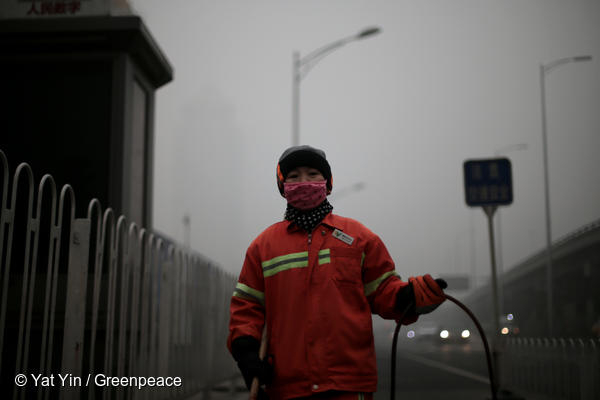-
China releases its energy sector development 13th five year plan: Greenpeace response
Beijing, 5 January, 2017 - China’s National Energy Administration’s national energy sector development 13th five year plan firms up the country’s coal consumption cap and puts the country on the path of a steady energy transition. World-leading levels of investment in renewable energy will be maintained, with the country planning to invest RMB 2.5 trillion…
-
460 million people in China are choking on dirty air
460 million people in China are currently choking under a cloud of smog larger than North America. China needs to speed up its renewables revolution!
-
Smog engulfs area home to 460 million citizens as Northern China sees worst air pollution of 2016 – Greenpeace
Beijing, 20 December 2016 - Northern China’s 23-city air pollution red alert has become the most serious air pollution episode of the year, affecting a population equivalent to that of the US, Canada and Mexico combined. Approximately 200 million citizens across six provinces are experiencing “hazardous” levels of smog, and a further 260 million seeing…
-
Red alert: What’s happening with Beijing’s air pollution?
As Beijingers wait to be engulfed by a slow-moving cloud of smog, data shows that air pollution progress is stalling.
-
Beijing’s first air pollution red alert of 2016, coal burning the culprit – Greenpeace
Beijing, 16 December, 2016 - A Greenpeace East Asia analysis of air pollution statistics identifies industrial coal burning in Beijing’s surrounding provinces as the primary source of the pollution which has triggered the red alert measures for 16-21 December. Greenpeace East Asia calls on the government to accelerate China’s economic transition, further curb coal consumption…
-
Media Update: Beijing PM2.5 carcinogen concentration falls as less coal burnt
Beijing, 14 November, 2016 - In 2013 Greenpeace East Asia, in collaboration with the Public Health Faculty of Peking University, reported that PM2.5 in Beijing contained levels of the heavy metal and group 1 carcinogen, arsenic, 3.85 times higher than the national standard.[1] The report also found worryingly high levels of two other carcinogens, cadmium…
-
Xi’an Environmental Protection Bureau caught tampering with air quality readings – Greenpeace response
Beijing, 25 October 2016 - It is shocking and concerning that the Xi'an Environmental Protection Bureau has consistently falsified air quality readings.[1]
-
Over 1 trillion rmb could be wasted on redundant coal power in China – Greenpeace report
Beijing, 13 July, 2016 – Beijing, 13 July, 2016 – Despite government attempts to reign in China’s coal power overcapacity crisis, Greenpeace research finds that a total of over 1 trillion rmb could be wasted on excess capacity by 2020. Despite a new overcapacity policy, China still has enough coal-fired projects in the pipeline to…
-
Greenpeace East Asia responds to IEA report on Energy and Air Pollution
Beijing, Monday June 27 - The IEA’s report on Energy and Air Pollution, released today, underlines the urgency in moving to clean forms of energy if we are to stop millions of premature deaths around the world. The WHO (World Health Organisation) estimates that 3 million people die every year from outdoor air pollution from…
-
Study on Economics of Coal-fired Power Generation Projects in China Report
After analyzing the thermal-power (coal-power) related phemonenon and data of the power sector in 2015, the mismatching of use and resources remains complex. With a 2.3% annual drop in thermal power generation and only 0.5% growth in total electricity consumption, the addition of installed capacity of coal-fired plants is incompatible with demand at 52,000 megawatts…










